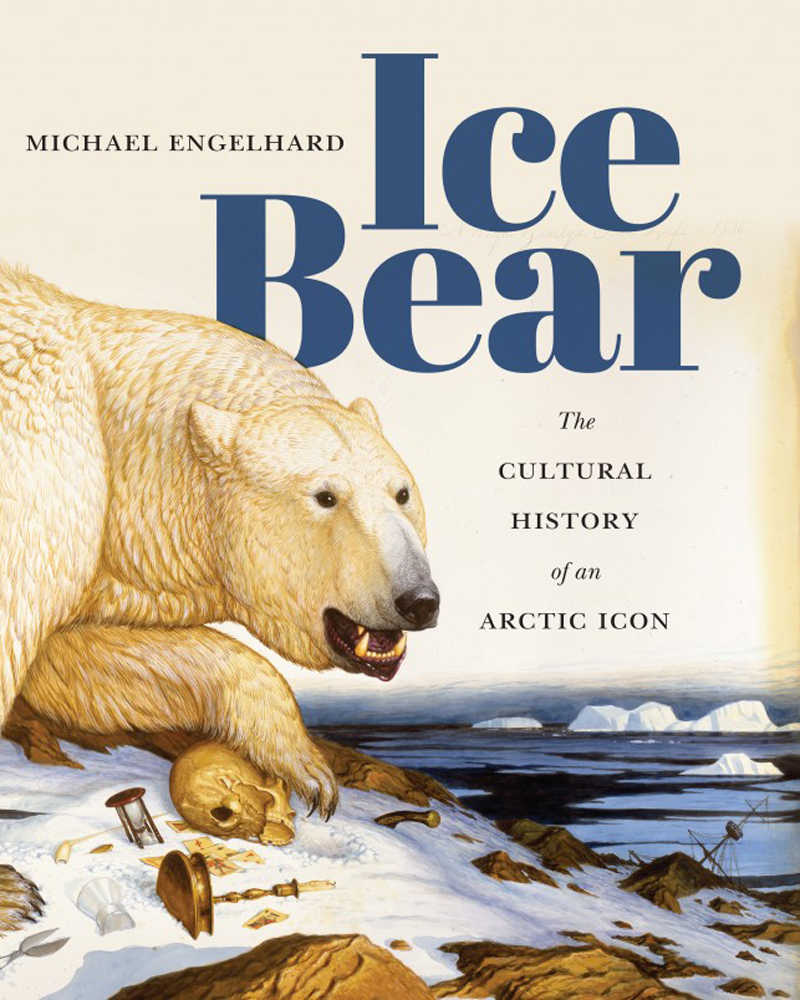The polar bear reigns supreme as the chief predator in the lands through which it roams. Across the ages these towering, white bears have been “feared, venerated, locked up, coveted, butchered, sold, pitied and emulated.” In other words, they have played as many roles in our human reality as an Elizabethan character actor might. Michael Engelhard’s delightfully exhausting analysis closely scrutinizes the variety of masks worn by this peripatetic, Arctic nomad.
Engelhard’s thought provoking iconography explores in depth the multitude of cultural roles played by the polar bear. He familiarizes us with this incredibly versatile marine mammal, who by way of its sheer enormous presence conjures up a host of real and imagined realities for the its beholder. In his opening chapter, “A Beast for the Ages,” Engelhard stresses his intent is to present this slew of cultural images without personal bias. He does an admirable job of stripping aside his own predilections, whatever they might be. In doing so, he exposes us to the litany of cultural interpretations that define polar bears in oh so many ways.
One prevalent motif throughout “Ice Bear” is the polar bear’s whiteness. Engelhard wrote: “The meaning of color, according to anthropologists and literary theorists, can magnify the meaning of an animal, and their combined meanings pack a double punch. Compared with animals of a different color a beast the color of winter is almost always better, stronger, and supernatural.” It is this other worldly nature that drove our understanding and relationship to polar bears. Whether pondering the duality of their nature (epitomized by their whiteness) or exploring our own dark, collective psyche through our projections upon these creatures, we always have found ways to slot them in a variety of disparate categories. They’ve been feared as beasts of brute strength, laughed at as celebrity entertainers within circuses and displayed in zoos as educational ombudsmen from their Arctic homes.
But, more than anything else, what has remained consistent from culture to culture are its supernatural powers. Not that the specific powers themselves are the same; it’s that each unique culture finds within this species its own metaphysical foundation. For example, it was not uncommon at all within Arctic folklore that the polar bear would be called upon by the local shaman to grant him the bear’s special powers – shape shifting being a common one. While many today may view it as strange, to say the least, for a shaman to execute his own death only to reappear in the skins of a bear to perform whatever sacred rite was required, at one point people accepted it as part of a shamanic ritual.
We even see this shape-shifting mythology streaming into our modern culture via pop music. “A music video for Björk’s ‘Hunter’ shows the singer shaking and convulsing and, with the assistance of computer-generated imagery, slowly and unwillingly turning into a polar bear. Such involuntary change or spirit possession is deeply rooted in shamanic tradition.”
It goes without saying that any animal who successfully inhabits as many personae as a polar bear is bound to be assigned a sexual identity. Whether that image has anything to do with reality or not is another story. And what better place for the sexualized bear to make his tawdry, grand entrance (when it came to sex and the polar bear the object of desire was always the male bear and his appeal and/or lustful nature) than the world of art? In 1907 the artist Leo Putz immortalized the sexual allure of the polar bear in his painting “Bacchanal,” which featured, among other images, a polar bear nuzzling a naked, nubile young woman. A. Goldwhite’s “Nude on a Bearskin Rug Orientalist”, painted around 1900, shows a young, naked slave girl on a polar bear rug. Engelhard goes on to describe a number of similar situations scattered throughout literature and the cinema.
Engelhard sums it up best when finalizing our relationship with the polar bear: “The only thing that can be said with certainty is that the polar bear has been and is many things to many people… Like the blank spots on explorers’ maps, it keeps us forever guessing its true nature.”
• David Fox is a freelance writer who resides in Anchorage. Contact him at dfox@gci.com.

